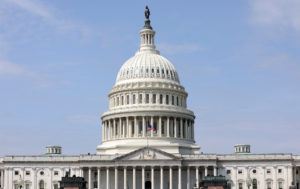
A long-awaited bipartisan border proposal has arrived for consideration in the U.S. Senate this week. After months of negotiations, Sens. James Lankford (R-Okla.), Chris Murphy (D-Ct.), and Kyrsten Sinema (I-Ariz.) released the text of their proposal that would bring about significant changes to the United States border and asylum system, while being paired with the national security supplemental funding bill for Ukraine, Israel, Taiwan and the southern border. As the legislative text was finalized over the last several weeks, it has been backed by Senate leadership of both parties as well as President Biden. But, upon release, the proposal is facing sharp criticism from both Republicans and Democrats.
Southern Baptists have spoken to the issue of immigration for decades, calling on Congress to secure our borders while upholding principles of compassion and human dignity.
What is included in this bipartisan border bill?
This sweeping bill contains a number of significant provisions as it relates to border and asylum policy as well as avenues for legal migration. Some of these provisions include:
- Funding for detention: Many migrants are not currently detained, but rather paroled into the U.S., because of a lack of space in detention facilities. This bill provides $7.6 billion to Immigration and Customs Enforcement (ICE), $3.2 billion of which is dedicated to increasing detention capacity.
- Funding for border patrol: Customs and Border Protection (CBP) face incredible staffing shortages and do not have the current resources to process and screen all who are arriving at the border. This bill provides $6.766 billion to CBP, giving them the ability to hire additional agents, improve technology for finding fentanyl, and to address trafficking-related issues.
- Major changes to the asylum system: Current U.S. law guarantees a right to seek asylum for individuals who step foot on U.S. soil. Because of that, many individuals who do not have valid asylum claims have flooded the asylum system, seeing it as their only viable option to enter the U.S. Unfortunately, because of backlogs, many of these individuals are in the U.S. for many years before their asylum claims are eventually denied. This proposal speeds up the adjudication process while also requiring a higher burden of proof in initial asylum screenings – a policy long sought by advocates seeking to curtail illegal immigration. Additionally, with faster adjudication of claims, the bill provides guidance for carrying out quicker expulsion and deportation for those who do not qualify. One change, flagged by critics, includes work permits for many who apply for asylum and HHS-provided lawyers for unaccompanied children under 14 to navigate this process.
- New “border shutdown” authority: One of the most significant and most misunderstood portions of the bill would create a new border emergency authority. As described in the authors’ summary, “The ‘border emergency authority’ may be exercised if the 7-day average number of cumulative encounters of inadmissible aliens is between 4,000 and 5,000 per day and must be exercised if the 7-day average is above 5,000 per day. Exercise of the authority is also required if the number of encounters on a single day exceeds 8,500. Unaccompanied minors from non-contiguous countries are not included in the total number of encounters for the purposes of this section. When use of the emergency authority is authorized, the Secretary has the authority to prohibit the entry into the U.S. of all individuals, except unaccompanied minors, between ports of entry and may only screen individuals for eligibility for withholding of removal or protection under the Convention Against Torture. Concurrently, U.S. Customs and Border Protection is required to continue processing a minimum of 1,400 inadmissible aliens per day across southwest land ports of entry under expedited removal or the 235B non-custodial removal proceedings contained in this title, ensuring that access to the asylum system remains available.”
- Border wall: This bill would require the Biden administration to continue construction of the border wall with Mexico. While the policy was most prominent during former President Trump’s administration, initial construction of various portions of a border fence began under former President George H.W. Bush.
- Anti-fentanyl measures: In addition to funding for new fentanyl screening technology, the bill also includes policies aimed at curbing the flow of fentanyl into the U.S. It also provides funding to the Drug Enforcement Administration (DEA) to aggressively target cartels involved in smuggling fentanyl.
- Afghan Adjustment Act: In 2021, the U.S. assisted many Afghans, including many of our military allies, in fleeing to the U.S. following the fall of Afghanistan to the Taliban. Since then, these individuals have been in the country without any pathway to a permanent status. The bill includes the Afghan Adjustment Act which would provide such a pathway following additional screening.
- Additional visas: The bill authorizes an additional 250,000 immigrant visas over the next five years divided between those coming for employment-based reasons and those seeking to reunify with family.
In addition to these immigration-related provisions, the bill includes funding for assistance to Ukraine, Israel, the Indo-Pacific region, and to restoring U.S. military readiness.
If you’d like more details about the contents of this bill, you can read a full summary here.
Why is this significant?
The current situation at the southern border is untenable. In December of 2023, there were more than 300,000 individuals encountered at the border, the highest number ever recorded. This flow of migrants is overwhelming the American resources at the border to process, screen, detain, and care for those who are arriving. As our ERLC team observed when we visited the border in 2022, U.S. border patrol officers are desperately in need of additional resources and help.
Compared to current levels, these proposed reforms would provide meaningful assistance to border patrol and those tasked with securing our border while making changes that could significantly reduce the number of migrants who initially qualify for asylum. Along with increased detention capacity and faster adjudication, these changes could make progress toward ending so-called “catch and release.” Senator Lankford termed the new policies “detain and deport.”
Additionally, though the president does have substantial authority in deciding border-related policies, that power is limited by existing law that guarantees those who arrive on U.S. soil the right to request asylum. The proposed changes to asylum coupled with the new “border shutdown” authority could provide the executive branch with increased powers to severely limit the number of individuals accepted into the U.S., particularly at times when border resources are overwhelmed.
No significant updates have been made to the U.S. immigration system or border security laws since the 1980s. When compared to current law, these proposals would mark a meaningful shift in U.S. policy and provide new power to the executive branch.
How does this compare to what Southern Baptists have said about immigration?
At the 2023 SBC Annual Meeting, Southern Baptists passed a resolution “On Wisely Engaging Immigration.” This resolution followed many others passed by Southern Baptists over the past decades. Relevant parts of the most recent resolution read:
RESOLVED, That we ask our government leaders to provide clear guidance for immigrants and asylum seekers regarding border policies, legal entry into this country, and work opportunities; and be it further
RESOLVED, That we implore our government leaders to maintain robust avenues for valid asylum claimants seeking refuge and to create legal pathways to permanent status for immigrants who are in our communities by no fault of their own, prioritizing the unity of families; and be it further
RESOLVED, That we encourage elected officials to prioritize measures that secure our borders and to provide adequate resources to border patrol and those working in our immigration system; and be it further
RESOLVED, That we urge our government to take swift and bold action to protect and prevent the exploitation of unaccompanied immigrant children arriving to the United States; and be it further
Southern Baptist Resolution ‘On Wisely Engaging Immigration’
On many of these counts, this legislation is in line with these requests. This proposal would offer clearer guidance to those coming to the border, laying out new policies regarding work authorizations and vowing quick expulsion for those without valid asylum claims. Though some may disagree about the efficacy of various measures in securing the border, this is certainly a step forward from the current chaos (though some feel it does not enhance security measures enough). In addition to providing resources and policy changes that would make the border more secure, the proposal retains key narrow avenues for those with valid asylum claims to make their case. In nearly all changes within the bill, special care and attention is given to the unique situation of unaccompanied immigrant children.
Though the bill does provide some new legal avenues for those who would come to the U.S. and includes a pathway to permanent status for Afghans who were brought to the U.S. following the fall of Afghanistan, a measure that the ERLC has long advocated for, it does not provide any path forward for the broader undocumented population or for Dreamers, the young immigrants brought here as children. Some opponents of the proposal have called it a blanket amnesty plan, though no such provisions exist.
What happens next for this bipartisan border proposal?
Members of both parties have pushed back on this proposal. Three Democratic Senators, including former presidential candidate Bernie Sanders, immediately signaled their disapproval of the bill. House Republican leaders released a statement saying consideration of the proposal would be a “waste of time” in their chamber. Support quickly faded from several Senate Republicans as well. While some don’t believe that the bill is strong enough on border security, others argue against addressing the issue of the southern border in an election year.
At this point, the path forward looks highly tenuous for this proposal though attempts to amend it could be made in the legislative process. Currently, the Senate is expected to take an initial procedural vote on the bill on Wednesday (Feb. 7). If the supplemental is unable to move forward, it raises the important question of what happens next in regards to defense funding for Ukraine, Israel, the Pacific, and the border. It should be noted funding deadlines for the government are set for March.
















